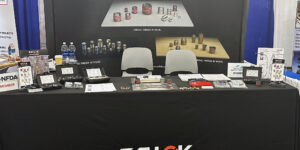THE WORLD IS NOT FLAT: TIPS TO IMPROVE OUT-OF-POSITION WELDING (Part Two: Stick Welding)
Fabricators often need to weld out-of-position when working with large/heavy weldments and with pipe, which requires adjusting the electrode angle, puddle manipulation, body position and equipment settings. In the conclusion of this two-part series, Ken Alrick of Thermadyne focuses on stick welding mechanics and shows operators the variables that can help them control weld puddle and weld bead profile.
Posted: October 30, 2011
Fabricators often need to weld out-of-position when working with large/heavy weldments and with pipe, which requires adjusting the electrode angle, puddle manipulation, body position and equipment settings. The conclusion of this two-part series focuses on stick welding mechanics and shows operators the variables that can help them control weld puddle and weld bead profile.
Last month, the first part of this article focused on TIG welding out-of-position. Now we examine stick welding mechanics. As a reminder and review from that discussion, operators can control weld puddle and weld bead profile by manipulating the following variables:
- Amperage. Reduce amperage by 15 percent for out-of-position welding.
- Arc length. Generally, arc length should equal electrode diameter. Because voltage is directly proportional to arc length, operators often hold a shorter arc to reduce heat when welding out-of-position.
- Electrode work angle. The angle of the electrode relative to the joint.
- Direction of travel. Usually described in terms of push/forehand or drag/pull/backhand.
- Electrode travel angle. The angle at which the electrode travels.
- Electrode (torch) manipulation. More on this below.
- Travel speed. If the travel is too fast, the bead will be narrow and strung out and may even be broken up into individual globules. If the travel is too slow, the weld metal piles up and the bead will be too large.
“The importance of holding a short arc when stick welding out-of-position cannot be overstated. It’s the number one mistake beginners make,” says Todd Hidde, the shop superintendent for the Pipe Fabrication Division of J. F. Ahern Co. (Fond du Lac, WI), a leading mechanical, fire protection and pipe fabrication contractor. “For a 1/8 in diameter electrode, this means an arc length of 1/16 to 1/8 of an inch. Longer arcs increase heat and the metal comes across the arc in large, irregular globs.”
In addition to these controls, Chris Brownlee, CWI and weld process specialist for Weld Specialty Supply Corp. (Milwaukee, WI), notes that, “Most professional-grade stick/TIG inverters feature an adjustable arc force control that adjusts the ‘dig’ settings on a scale from 0 – 10. With 2 being neutral, use settings greater than 2 for a harder, more driving arc, which especially helps a 7018 rod get into tight joints. Use settings less than 2 for a softer arc with lower spatter and less penetration. This is especially helpful when welding with 6010 rods.” (See Figure 1)
HORIZONTAL-VERTICAL FILLET WELD
The first “out-of-position” weld the beginner is likely to encounter is a horizontal-vertical (HV) fillet weld. After striking the arc, immediately bring the electrode to a position perpendicular to the line of the fillet and about 45 deg from the vertical. Drag the electrode at an angle of about 20 deg from the perpendicular position to prevent slag from running ahead of the weld. (See Figures 2, 3)
WELDING HORIZONTAL
When arc welding in the horizontal position, the operator needs to use arc force to counteract the weld puddle’s desire to sag toward the bottom of the joint. To properly direct arc force, just remember “20-20” – point the rod up at about 20 deg and drag it at about a 20 deg angle.
At first, operators may notice a tendency for undercut to form, but keeping the arc length short, the amperage 15 percent lower, the electrode angle at 20-20 and the rate of travel not too fast will help eliminate this. For deep grooves and welds requiring multiple passes, make a series of stringer beads. Remember to recalculate the electrode angle in relationship to the previous stringer bead and sidewall.
In this situation, make the root pass with little or no electrode weave. As you weave for subsequent passes, remember the “dime wide, nickel high” rule when using a 1/8 in diameter electrode: the bead crown should be no more than one electrode diameter high and no more than three diameters wide. (See Figure 4)
VERTICAL UP AND DOWN
Beginners may have heard the expression when there’s slag, you drag. That is true for the flat and horizontal position, but forget about it for the vertical up and down position.
“For welding vertical up, the weld puddle and slag will constantly try to fall back down and fight the welder’s efforts to get good penetration,” says Hidde. “To combat this, the rod angle may be anywhere from straight in to a push angle of 10 deg or 20 deg.” (See Figure 5)
Some welders get best results on the root pass without any weave at all, while others prefer a slight weave. “The weave pattern I like for vertical up resembles a smiley face,” says Hidde. “I imagine that I’m pushing the metal up and freezing it to the sidewall, dipping quickly across the center of the weld, pushing the molten pool up the other sidewall and holding for a ‘1001’ count for good penetration.”
Brownlee adds that, “Other welders often imagine they’re building a shelf or stacking bricks on a wall. The first weld bead acts like a base on which subsequent beads can be stacked.” He adds that after the first few passes, transitioning to more of a straight Z weave pattern is acceptable. (See Figure 6)
Another common mistake beginners make is to spend too much time in the center of the weld, producing a weld with a high crown that could lead to a stress riser. Flatten the bead by lingering longer at the sides of the weld.
When welding downhill, Hidde says that, “Swap out the smiley face motion for a downhill frown. Try to push the metal up and out of the center, move it over and tie it in to the edges. All downward motion and pauses of the rod should be along the sides of the weld with a push up motion across the center.” (See Figure 7)
OVERHEAD
Observing all of the data, images and advice on overhead welding produces a hodge-podge of results, especially as welding overhead on pipe differs from welding overhead on plate. Because plate stays in the same plane, consider using a drag angle of 10 deg or less. When pipe welding, the overhead position quickly transitions to the vertical up position, indicating that an angle of 0 deg to a 10 deg push angle is more appropriate for overhead welding. (See Figure 8, 8B)
As for electrode manipulation, first try welding without any. The object when welding overhead is to keep the puddle as small as possible, and a straight drag accomplishes this. Otherwise, consider a small circular or C motion; forward movement of the rod will allow the back part of the puddle to cool.
Keep an especially tight arc when welding overhead. Some experts believe that operators should be able to actually feel the electrode brushing against the metal. In cases such as these, inverters with arc force control help prevent the rod from sticking. Otherwise, use a smaller diameter rod (to produce a smaller, more controllable puddle) and enough amperage to prevent it from sticking.
“Electrode manipulation and rod angles tend to be very personal,” says Hidde. “What works for me might not work for you. The important thing to do is to read the weld puddle and slag and how gravity affects them; then, adjust rod angle, arc length and manipulation accordingly.”
In conclusion, Brownlee adds that welding out of position also demands extra caution with personal protective equipment. “High quality welding leathers are a must to protect against molten metal.”










